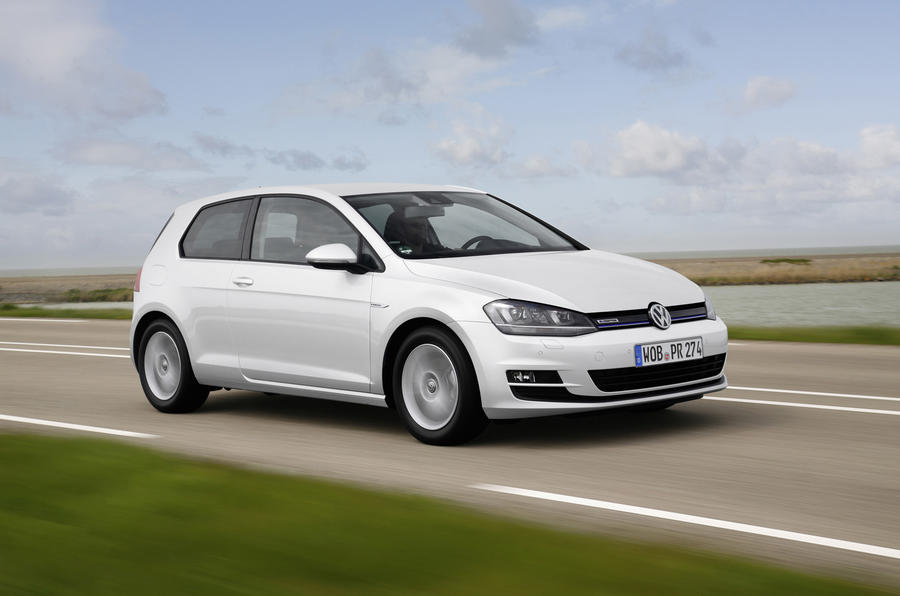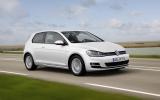What is it?
The first petrol-powered model to be launched under the company’s ‘Bluemotion’ branding.
It’s powered by a new 999cc three-cylinder turbocharged engine based on the impressive unit currently used in the Up city car. The headline claims are for an official CO2 rating of 99g/km and 65.7mpg on the combined cycle.
There’s no doubt that this engine is something of an engineering gem. Volkswagen claims it has the highest specific torque output of any "large-scale series production petrol engine", with 147lb ft being produced by just 999cc.
This three-cylinder unit is part of the EA211 engine family and based around a die-cast crankcase made from a sophisticated aluminium alloy. The exhaust manifold is integrated into the cylinder head and fitted with a cooling jacket which is fed from the engine’s main cooling system.
Two advantages are gained from this. Firstly ,the exhaust gases can help get the engine’s coolant up to operating temperature more quickly, which is essential for maximum fuel efficiency. Secondly, at high speeds the coolant helps cool the exhaust gases before they are sent to drive the turbocharger.
The turbocharger’s impressively compact intercooler – which is integrated into the engine’s intake manifold system – is also connected to the engine’s cooling system. Usually, intercoolers are air cooled and mounted remotely from the engine, being sited by the radiator in the nose of the car.
The Golf's set-up is far more space-efficient and greatly reduces the distance intake air has to travel to be cooled before heading for the turbocharger.
Another nice touch is the cylinder head cover, which is made from aluminium and has the mountings for the valve train integrated into its underside.
The direct injection system works through five-hole injectors and uses a maximum of 250bar, which is unusually high for a petrol engine. VW has also specified a toothed belt to drive the valve train. This is claimed to reduce friction by 30% compared with a chain drive. It is also said the belt will last the lifetime of the car.
The final piece of engineering magic relates to the engine's balancing. A three-cylinder four-stroke engine has an inherent lack of internal balance that manifests as a distinctive ‘thrumming’ vibration.
Normally a crankshaft-driven balancer shaft would be fitted to such an engine, but VW's engineers wanted to avoid the expense, bulk and power-sapping friction developed by a conventional balancer shaft.
VW’s solution - as used by Audi in the 1980s on its big five-cylinder engines - is to use a deliberately unbalanced flywheel and crankshaft pulley. The carefully calculated ‘unbalancing’ of these components, each of which is mounted on opposite ends of the crankshaft, cancels out the internal imbalances of the engine at virtually no cost. The crankshaft pulley, for example, is ‘unbalanced’ simply by cutting out sections of the pulley face, making it heavier at one side.
The whole engine weighs in a just 89kg, or 10kg lighter than the four-cylinder 1.2-litre TSI engine launched with the Golf Mk7.



















Join the debate
Add your comment
I have to agree with the naysayers
OK, an Auris or Prius (or even Lexus CT200h) might not have the appeal of a Golf, but if reliability is important to you then Toyota has it without question.
No turbo, no high pressure fuel system, no DPF, no clutch or flywheel and upwards of 60 mpg on petrol if you're careful - Toyota has it nailed. Our Prius feels nearly indestructible. It's coming up for 6 years old and just refuses to go wrong - ever.
On the other hand, if you're a company car driver or leasing a car on PCP giving it back at the end, there's a lot to be said for the Golf. Probably won't cause too much trouble in those first three years and will feel like a much more premium ownership experience, if that matters to you.
Now I know
45mpg?
Mini2 wrote: If Autocar think
I know plenty of people who have the Dci 1.5 diesel engine in their cars who regularly achieve 70mpg so don't think this will tempt them away. But 45mpg from a petrol is commendable.